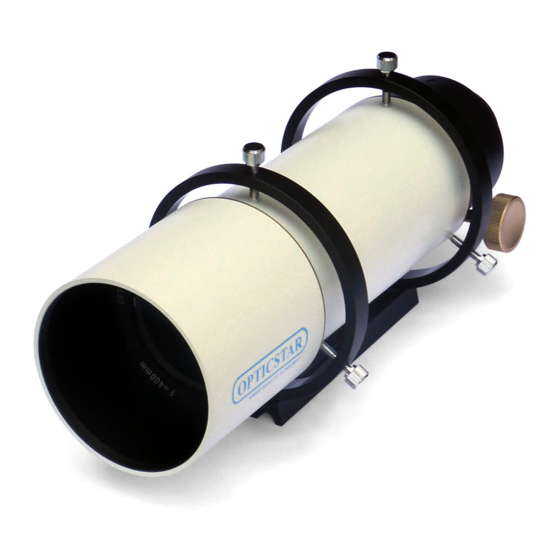Advertisement
Quick Links
Advertisement

Summary of Contents for Opticstar AR80S
- Page 2 © Opticstar Ltd 2011...
- Page 3 FINDERSCOPE WILL CAUSE INSTANT AND PERMANENT DAMAGE TO YOUR EYES. CHILDREN SHOULD AT ALL TIMES BE SUPERVISED BY A RESPONSIBLE ADULT WHILE OBSERVING. Do not disassemble your telescope, there are no user serviceable parts inside. Disassembling the lens cell will invalidate your warranty. © Opticstar Ltd 2011...
- Page 4 Introduction Congratulations on the purchase of your Opticstar AR80S achromatic refractor. This AR80S telescope is well suited for both astronomical and terrestrial observation. Its high quality achromatic optics, solid construction and very low focal ratio of f5 make it also ideal for deep sky imaging, for use as a guider, or as a travel and spotting scope.
-
Page 5: Mounting The Telescope
5. Point the telescope to a distant land object (i.e. the top of a lamp post, tree or chimney). You will notice that the image will be mirrored and/or upside down, this is normal for an astronomical telescope. © Opticstar Ltd 2011... - Page 6 If you do not use a diagonal you will need an extension tube to reach focus. Using the AR80S If you are new to observing it is advisable to first use the telescope during daytime to learn how it operates.
- Page 7 Earth. Its orange colour is prominent and surface markings are visible as are the Polar caps when present. Venus can be observed early in the morning before dawn or just after sunset. Venus appears quite large in the telescope but its atmosphere will hide any surface detail. © Opticstar Ltd 2011...
- Page 8 The fast focal ratio of the AR80S scope makes ideal for deep sky viewing and imaging or for use as guide scope. When conditions are not favourable the maximum useful magnification for most scopes will be around 25-35 times per inch of aperture.
-
Page 9: Observing The Sun
(O3, H-alpha, S2) are recommended depending on requirements. The AR80S is suited for wide field deep-sky imaging due to its low focal ratio, solid structure and Precision Focuser. It is well suited for deep sky imaging when coupled with the Opticstar DS336 XL TEC-cooled camera which supports long exposures in conjunction with very low noise levels. -
Page 10: Eyepieces And Magnification
For example a telescope with a focal length of 400mm and an eyepiece with a focal length of 5mm will magnify its target 80 times (400/5=80). Barlow lenses can be employed in conjunction with an eyepiece to increase magnification. To calculate the magnifying power an eyepiece gives in conjunction © Opticstar Ltd 2011... -
Page 11: Field Of View
The focal ratio represents the speed of the telescope’s optics, the focal ratio can be calculated by dividing the focal length by the telescope’s aperture. Telescopes with faster/shorter focal ratios like the AR80S benefit from wider fields of view, and a subsequent increase in brightness and image resolution. Fast f/4-f5 focal ratios are generally best for lower power wide field observing and deep space imaging. - Page 12 Dual-speed Focuser Adjustme nt If your AR80S came with a 1:10 dual-speed focuser this would had been adjusted at the factory. In certain cases it may be necessary to regulate the tension to improve performance by adjusting the silver thumb-screw below the focuser, not too much and not to little.
- Page 13 A scraping noise will indicate that contact is made in which case the knobs will have to be slightly spaced out and re-tightened. You will now need to adjust thumb-screw D, it should now be possible to obtain the desired result. © Opticstar Ltd 2011...
- Page 14 As such it is important not to unnecessarily over- tighten the thumb-screw. An Imaging Setup The Opticstar short tube refractors are ideal for deep sky imaging. They can be used as part of an imaging system as illustrated below. © Opticstar Ltd 2011...
- Page 15 APPENDIX C Opticstar AR80S OTA Specification Aperture 80mm Focal ratio F7.5 Objective Achromatic doublet Optical coatings Broadband FMC (fully multi-coated) Optical tube Internally anti-reflection coated, knife-edge baffles Dew shield Retractable with metal screw-type cap Finder-scope saddle Non guider versions only...
- Page 16 Opticstar Ltd 87 Washway Road, Sale Greater Manchester M33 7TQ United Kingdom WEB: www.opticstar.com - EMAIL: info@opticstar.com © Opticstar Ltd 2011...



Need help?
Do you have a question about the AR80S and is the answer not in the manual?
Questions and answers